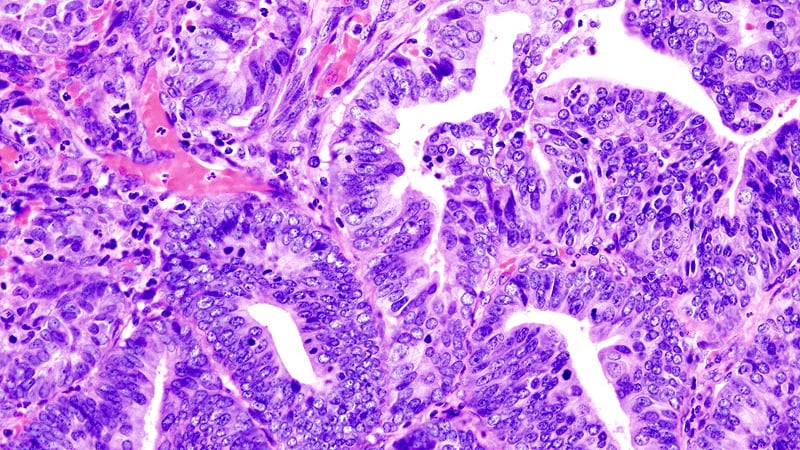Immunotherapy and PARP Inhibitors in Endometrial Cancer Treatment
Core Concepts
Adding immunotherapy to chemotherapy improves outcomes in endometrial cancer, with questions on the benefits of adding PARP inhibitors.
Abstract
The research presented at the ESMO Annual Meeting 2023 highlights the advantages of combining immunotherapy with chemotherapy in advanced or recurrent endometrial cancer. Two trials, AtTEnd and DUO-E, demonstrated improved progression-free survival (PFS) with the addition of immunotherapy. The AtTEnd trial focused on atezolizumab, showing significant PFS benefits, especially in patients with mismatch repair-deficient (dMMR) disease. The DUO-E trial explored the combination of durvalumab and olaparib with chemotherapy, also leading to improved PFS, particularly in dMMR patients. The studies suggest a positive impact on women with gynecological cancers, emphasizing the incorporation of immunotherapy into standard care.
Double Good, Triple Therapy Better in Endometrial Cancer?
Stats
Adding immunotherapy to chemotherapy improved progression-free survival (PFS) among all-comers — 28.1% vs 17% at 2 years.
Mismatch repair-deficient disease patients receiving atezolizumab demonstrated an early overall survival benefit.
Adding durvalumab to chemotherapy followed by maintenance durvalumab with or without olaparib led to a significant improvement in PFS compared with chemotherapy alone.
Quotes
"The molecular classification of endometrial cancer is now leading us to areas that we didn't think before [were] possible." - David S.P. Tan, MD, PhD
"The main limitation of the trial is that it was not powered to make a formal comparison between the two experimental arms." - Domenica Lorusso, MD, PhD
Key Insights Distilled From
by Liam Davenpo... at www.medscape.com 10-22-2023
https://www.medscape.com/viewarticle/997607
Deeper Inquiries
What are the implications of combining immunotherapy with chemotherapy in other types of cancer?
The combination of immunotherapy with chemotherapy has shown promising results in various types of cancer beyond endometrial cancer. This approach capitalizes on the synergistic effects of both treatments, where chemotherapy can enhance the immune response within the tumor, making it more susceptible to immunotherapy. Studies have demonstrated improved outcomes in cancers such as lung cancer, melanoma, and bladder cancer when combining these two modalities. The implications include increased response rates, prolonged progression-free survival, and in some cases, overall survival benefits. This combination therapy has become a standard of care in certain cancers and continues to be an area of active research for potential applications in other malignancies.
Is there a risk of over-treatment with the addition of PARP inhibitors in certain subsets of endometrial cancer patients?
The addition of PARP inhibitors to the treatment regimen for endometrial cancer patients, particularly in combination with immunotherapy and chemotherapy, raises concerns about the potential for over-treatment in certain subsets of patients. While PARP inhibitors have shown efficacy in specific populations, such as those with dMMR tumors, there is a risk of exposing patients to unnecessary toxicity and adverse effects if the benefits do not outweigh the risks. In the context of the DUO-E trial, the marginal benefit of adding olaparib to the treatment regimen, especially in patients with pMMR tumors, highlights the need for careful consideration of individual patient characteristics and tumor biology to avoid over-treatment. Personalized medicine approaches that take into account molecular classifications and predictive biomarkers can help identify patients who are most likely to benefit from PARP inhibitors, minimizing the risk of over-treatment.
How can the concept of molecular classification in cancer lead to personalized treatment strategies beyond immunotherapy and chemotherapy?
The concept of molecular classification in cancer plays a crucial role in guiding personalized treatment strategies beyond immunotherapy and chemotherapy. By identifying specific molecular alterations, such as dMMR status in endometrial cancer, clinicians can tailor treatment approaches to target the underlying mechanisms driving tumor growth and progression. This personalized approach allows for the selection of therapies that are most likely to be effective based on the individual patient's tumor biology, ultimately improving treatment outcomes and minimizing unnecessary exposure to potentially toxic treatments. Molecular classification also enables the identification of predictive biomarkers that can help stratify patients into subgroups that are more likely to respond to specific therapies, including targeted agents like PARP inhibitors. Moving forward, integrating molecular profiling into clinical practice will continue to drive the development of precision medicine strategies that optimize treatment efficacy and patient outcomes in cancer care.
0
